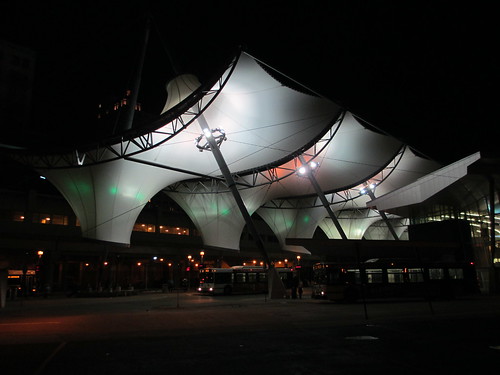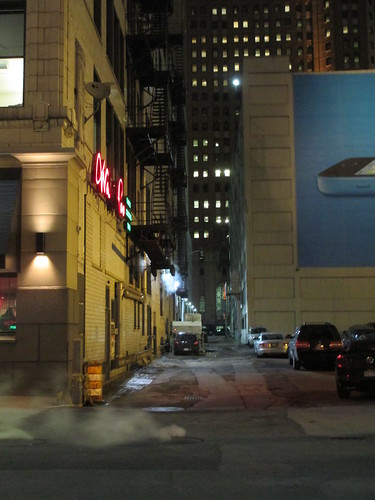On Sunday, January 11, as I have done on the equivalent
Sunday for three consecutive years, I flew from New
York LaGuardia Airport to Detroit
for the first day of events related to the annual North American International Auto Show. I took a taxi – the only really viable means of transport – to
downtown Detroit
for my first meeting. Then, lacking a bicycle – my preferred urban transport option - I started walking.
I walked from Greektown to the Rosa
Parks Transit
Center to catch a bus to Windsor , Ontario , where
my hotel was (there is, sadly, no way to walk across the Detroit River Windsor bus station to my hotel and back. I
walked from the Rosa Parks Transit
Center to Detroit ’s eastern market. I walked a mile
back to Greektown and then I walked back to the Rosa Parks Transit Center
I walked because I dislike being cooped up in cars and paying
for taxis. I prefer to get some exercise and see cities on a human level. But an
incident part way through the evening reminded me that walking can be a radical
– almost political – act, just as cycling is in some circumstances. In cities
that have been set up to suit only motor vehicles, someone who walks sets an
example of how it’s possible to break established patterns. Each pedestrian on
a once-deserted street helps to prove it can be safe to abandon the cocoon of a
motor vehicle.
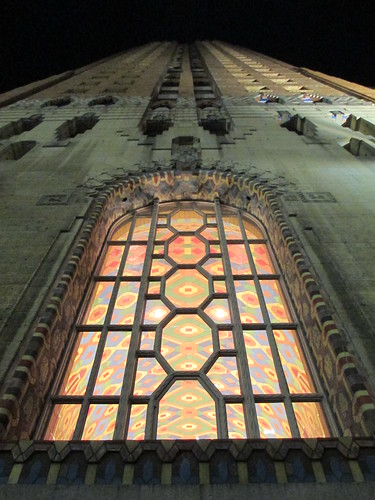 |
| Detroit's magnificent, art deco Guardian Building: the kind of detail it's worth taking a risk to see. |
Yet many of the people I meet when I go to Detroit think I’m simply inviting a mugging
or other violent crime by wandering through “dangerous” areas. Some of them, I
suspect, would be far from sympathetic if my foolishness led to my being hurt
or killed.
It’s an issue that resonates well beyond Detroit . On December 20, it emerged last
week, police in Montgomery County, Maryland, forcibly picked up two children –
Rafi Meitiv, 10, and Dvora Meitiv, six – whom their parents had allowed to walk
home from a park a mile away. The local government’s child services division is
investigating the parents for neglect. The numbers of children walking or
cycling to and from school in the UK have plummeted.
The walk from the bus station to Eastern Market helped to
remind me why walking remains a minority activity in many cities like Detroit . I walked on
sidewalks that were in poor repair and closed in places. I passed whole blocks
of empty, brownfield space. The motorists using the roads across these
wastelands were driving at grossly excessive speeds that made crossing the road
an uncomfortable experience. Although most of the sidewalks had been cleared of
the recent snow, not all had.
A considerable part of the walk was blighted by the presence
in the area of a vast cloverleaf interchange between the I-375 Interstate and
the Fisher Freeway. I walked on bridges over each, noting how, as some of Robert Moses' roads did in Brooklyn, they had cut through formerly coherent, walkable communities. Other streets
were effectively slip roads for the freeways, with vehicles driving at
commensurate speeds. The walk was also, thanks to Detroit ’s low-density, sprawling geography, a
mile-and-a-half, even though the areas looked close to each other on the city
map.
I nevertheless arrived safely and in good time for the event
I was planning to cover – the unveiling of some new models by General Motors’
Buick brand. I had the chance along the way to appreciate the fine architecture
of Trinity Lutheran Church Gratiot Avenue of how this neighbourhood must once have thrived . I was able to marvel at
the resilience of the Busy Bee hardware store at the corner of Gratiot and
Russell, still standing and serving customers when much of the surrounding area
was derelict. I was able to appreciate the skyline – a mixture of modern
attempts and redevelopment and art deco from the city’s early 20th
century heyday. I spotted how close my next appointment – with Volkswagen in
Greektown – appeared to be. I resolved to walk there too.
That resolve remained when I got a call from a colleague who
had been at another event and was being driven by its courtesy shuttle service to
Volkswagen. “Can my driver stop by and pick you up?” he asked. It was fine, I
replied – I would walk. My phone buzzed a few minutes later with a text
message. “Driver insisting we pick u up – safety an issue,” it read. My head
started whirling with the implications of what my colleague was saying, that
the driver was implying my behaviour was so foolish I should be given no choice
about persisting in it. “Tell him I walked here,” I texted back. I started on
what turned out to be a long search for my coat, for which I’d lost my coatcheck
ticket.
I considered, of course, the crime risks – the ones to which
my colleague’s driver was referring. It’s undoubtedly true that the Motor City Detroit ,
with a population of 700,000, in 2013 recorded 316 murders. That’s only just
short of the 334 recorded that year in New
York , which has a population of 8.4m. I kept my
iPhone mostly hidden as I walked, recognising it was one of the most obviously
stealable items in my possession. I kept my eyes wide open for any suspicious
activity.
But warnings against walking in Detroit don’t often feel to me based on
careful calculation of the crime risks in any given area. I once had an alarmed
auto company executive offer to find me a hotel room somewhere other than
touristy Greektown because she presumed the area so unsafe. The warnings tend
to come disproportionately from white residents of Detroit ’s outer suburbs who never venture
into the city proper outside a motor vehicle. Many people’s fears seem to
reflect the high numbers of homeless people panhandling for money in some
areas. I had one such person shout at me as I walked from the bus station to
the Eastern Market. But, while I’ve sometimes had such panhandlers follow me
for considerable distances, I’ve never felt seriously in danger.
It is certainly not comfortable to encounter the myriad
social problems from which Detroit
– which is mainly poor, 85 per cent black and whose city government has only
just emerged from bankruptcy - suffers. “It’s because of you I caught my domestic
violence conviction!” I heard a man shouting into his iPhone one night at the Rosa Parks
Transit Center
There is no doubt at all, meanwhile, that the thinking that
constrains the lives of children like the Meitivs is seriously flawed. Parents
typically give far less freedom of movement to children than 40 years ago, yet
rates of crime against children are far lower than they were then.
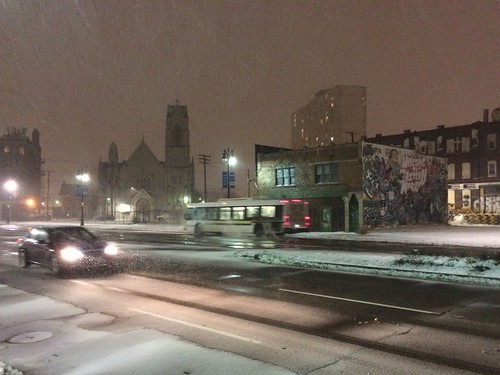 |
| Gratiot Avenue in the snow: my colleague's driver understood none of why I was prepared to walk in these conditions. The empty sidewalks show how many people share his opinion. |
It consequently felt like almost a moral imperative when the
driver said I shouldn’t be walking to prove that it was indeed possible to do
so. Having finally located my coat, I strode purposefully towards the exit. I
kept striding even once I’d discovered, to my mild consternation, that it had
started snowing steadily while I was inside. I was soon on my way back down Gratiot Avenue ,
face buried in my collar against the wind, towards the Volkswagen press event.
Later that evening, my colleague and I both walked to the bus stop by the
entrance to the cross-border tunnel. On the way, we saw almost no-one outside a
motor vehicle. The walking felt mundane, rather than risk-laden.
In the days since, however, the experience of getting around
Detroit and Windsor by bus and on foot has played on my
mind. I’ve been considering it particularly over the past weekend, which
includes a holiday to remember Martin Luther King, jr, the civil rights leader.
In that context, the name of Detroit ’s central
bus station – the Rosa
Parks Transit
Center Detroit – who drew Dr King into the
civil rights movement through her famous refusal to give up her seat on a bus
in Montgomery , Alabama
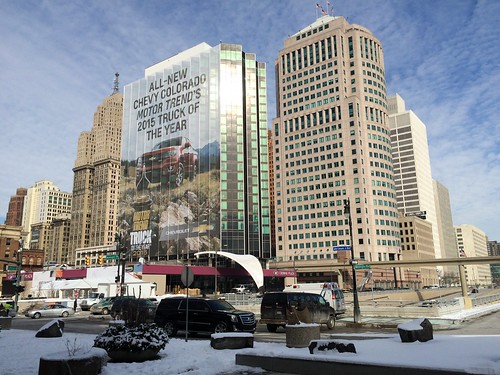 |
| Downtown Detroit in auto show week: it looks smart - but what would Martin Luther King make of the way its people get about? |
The battle over shared space on buses that Ms Parks set off
was possible, it occurs to me, only because black and white people in Montgomery were indeed
sharing space on public transport. Such a struggle is unthinkable in
contemporary Detroit
largely because white and black people so seldom share space when getting
about. They are closeted either in private motor cars or on a bus system that
almost no whites use
It would be fatuous, of course, to claim that my stubborn
determination to walk a few times in Detroit
did anything to alter those dynamics. The risks of crime in the city are real
and substantially higher than in New York ,
which remains less safe on average than the UK . My stance will look less clever
if, one day, I find myself beaten to a pulp over my phone or laptop – or worse.
But, as I walked past lonely, derelict buildings, I imagined
how the now-abandoned stores must once have relied on passing foot traffic. The
scaring away of pedestrians after Detroit
